
Pteris (brake) is a genus of about 300 species of ferns in the subfamily Pteridoideae of the family Pteridaceae. They are native to tropical and subtropical regions, southward to New Zealand, Australia, and South Africa, north to Japan and North America. 78 species are found in China. Some species of Pteris have considerable economic and ecological value, such as Pteris multifida, Pteris ensiformis, Pteris vittata can be used for ornamental purposes; as a hyperaccumulator, Pteris multifida and Pteris vittata can be used to control soil pollution.
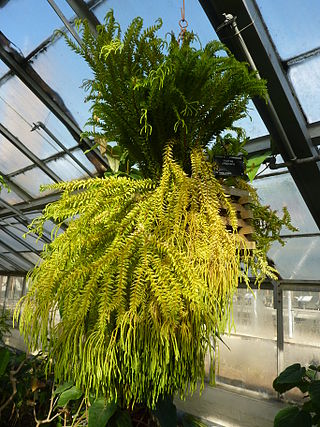
Phlegmariurus is a genus of lycophyte plants in the family Lycopodiaceae. The genus is recognized in the Pteridophyte Phylogeny Group classification of 2016, but not by some other sources, which keep it in a broadly defined Huperzia.

Microsorum is a genus of ferns in the family Polypodiaceae, subfamily Microsoroideae, according to the Pteridophyte Phylogeny Group classification of 2016 (PPG I). The species are tropical. Like most ferns, they grow from rhizomes, rather than roots. The genus name is often misspelled "Microsorium" or "Microsoreum". It includes some species that are lithophytic rheophytes.
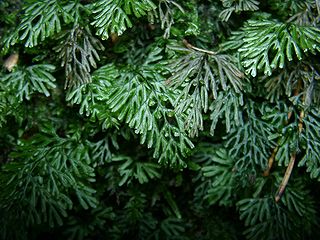
The Hymenophyllaceae, the filmy ferns and bristle ferns, are a family of two to nine genera and about 650 known species of ferns, with a subcosmopolitan distribution, but generally restricted to very damp places or to locations where they are wetted by spray from waterfalls or springs. A recent fossil find shows that ferns of Hymenophyllaceae have existed since at least the Upper Triassic.

Bolbitis is a genus of ferns in the family Dryopteridaceae, subfamily Elaphoglossoideae, in the Pteridophyte Phylogeny Group classification of 2016.

Hymenophyllum is a genus of ferns in the family Hymenophyllaceae. Its name means "membranous leaf", referring to the very thin translucent tissue of the fronds, which gives rise to the common name filmy fern for this and other thin-leaved ferns. The leaves are generally only one cell thick and lack stomata, making them vulnerable to desiccation. Consequently, they are found only in very humid areas, such as in moist forests and among sheltered rocks. They are small and easy to overlook.

Tectaria is a genus of fern in the family Tectariaceae, according to the Pteridophyte Phylogeny Group classification of 2016. Halberd fern is a common name for species in this genus.
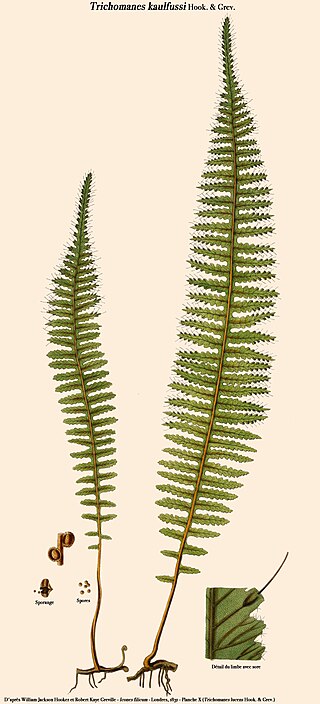
Trichomanes is a genus of ferns in the family Hymenophyllaceae, termed bristle ferns. The circumscription of the genus is disputed. All ferns in the genus are filmy ferns, with leaf tissue typically 2 cells thick. This thinness generally necessitates a permanently humid habitat, and makes the fronds somewhat translucent. Because of this membrane-like frond tissue, the plant is prone to drying out. “Filmy ferns” in the taxa Hymenophyllaceae grow in constantly wet environments. Many are found in cloud forests such as “Choco” in Colombia. There are also members of the taxa that can grow submersed in water.

Arthropteris is a small genus of ferns in family Tectariaceae, according to the Pteridophyte Phylogeny Group classification of 2016. It was previously placed in the families Oleandraceae or Davalliaceae. The genus is native to Australia, Europe, Asia and Africa. Around 12 to 21 species are considered part of this genus. The name Arthropteris is from the Greek, meaning "jointed fern", referring to the joint at the base of the petiole.
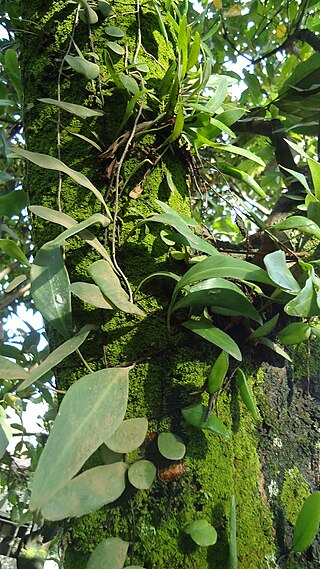
Pyrrosia is a genus of about 100 fern species in the polypod family, Polypodiaceae. Like other species in Polypodiaceae, the species of Pyrrosia are generally epiphytic on trees or rocks, a few species are terrestrial. The Latin name of Pyrrosia comes from the Greek pyrrhos (red), which refers to its leaves that are red due to the sporangia.

Cephalomanes is a fern genus in the family Hymenophyllaceae. The genus is accepted in the Pteridophyte Phylogeny Group classification of 2016 but not by other sources, which sink it into a broadly defined Trichomanes.

Goniophlebium is a genus of ferns in the family Polypodiaceae, subfamily Microsoroideae, according to the Pteridophyte Phylogeny Group classification of 2016 (PPG I).

Callistopteris is a fern genus in the family Hymenophyllaceae. The genus is accepted in the Pteridophyte Phylogeny Group classification of 2016 but not by some other sources, which sink it into a broadly defined Trichomanes.

Polyphlebium is a fern genus in the family Hymenophyllaceae. The genus is accepted in the Pteridophyte Phylogeny Group classification of 2016 but not by some other sources.

Vandenboschia is a fern genus in the family Hymenophyllaceae. The genus is accepted in the Pteridophyte Phylogeny Group classification of 2016 but not by some other sources.
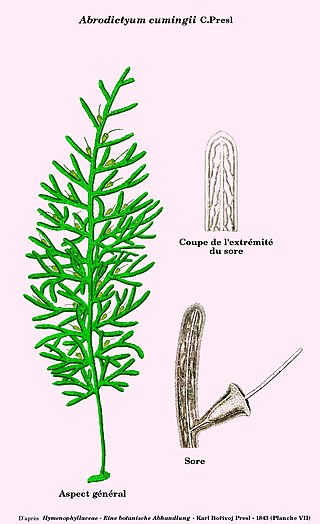
Abrodictyum is a fern genus in the family Hymenophyllaceae. The genus is accepted in the Pteridophyte Phylogeny Group classification of 2016 but not by some other sources, which sink it into a broadly defined Trichomanes.

Cephalomanes atrovirens is a species of fern in the family Hymenophyllaceae. The genus Cephalomanes is accepted in the Pteridophyte Phylogeny Group classification of 2016, but not by some other sources. As of October 2019, Plants of the World Online sank the genus into a broadly defined Trichomanes, while treating the subtaxa of this species as the separate species Trichomanes acrosorum, Trichomanes atrovirens, Trichomanes boryanum and Trichomanes kingii.

Goniopteris is a genus of ferns in the family Thelypteridaceae, subfamily Thelypteridoideae, in the Pteridophyte Phylogeny Group classification of 2016. Other sources sink Goniopteris into a very broadly defined genus Thelypteris.

















